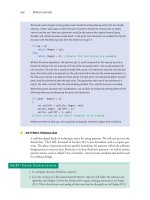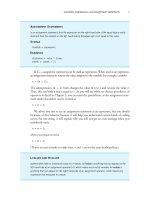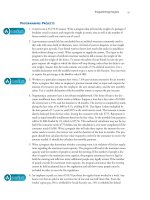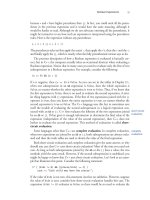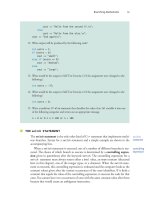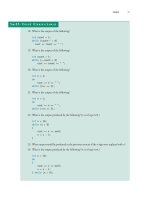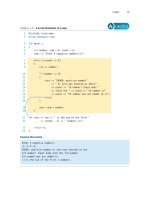Absolute C++ (4th Edition) part 3 doc
Bạn đang xem bản rút gọn của tài liệu. Xem và tải ngay bản đầy đủ của tài liệu tại đây (213.07 KB, 10 trang )
Variables, Expressions, and Assignment Statements 21
an addition, it is usually best to include the parentheses, even if the intended order of
operations is the one dictated by the precedence rules. The parentheses make the
expression easier to read and less prone to programmer error. A complete set of C++
precedence rules is given in Appendix 2.
■
INTEGER AND FLOATING-POINT DIVISION
When used with one or both operands of type double, the division operator, /,
behaves as you might expect. However, when used with two operands of type
int, the
division operator yields the integer part resulting from division. In other words, integer
division discards the part after the decimal point. So,
10/3 is 3 (not 3.3333…), 5/2 is 2
(not 2.5), and 11/3 is 3 (not 3.6666…). Notice that the number is not rounded ; the
part after the decimal point is discarded no matter how large it is.
The operator
% can be used with operands of type int to recover the information
lost when you use
/ to do division with numbers of type int. When used with values of
type
int, the two operators / and % yield the two numbers produced when you per-
form the long division algorithm you learned in grade school. For example,
17 divided
by
5 yields 3 with a remainder of 2. The / operation yields the number of times one
number “goes into” another. The
% operation gives the remainder. For example, the
statements
cout << "17 divided by 5 is " << (17/5) << "\n";
cout << "with a remainder of " << (17%5) << "\n";
yield the following output:
17 divided by 5 is 3
with a remainder of 2
When used with negative values of type int, the result of the operators / and % can
be different for different implementations of C++. Thus, you should use
/and % with
int values only when you know that both values are nonnegative.
N
AMING
C
ONSTANTS
WITH
THE
const
M
ODIFIER
When you initialize a variable inside a declaration, you can mark the variable so that the program
is not allowed to change its value. To do this, place the word
const in front of the declaration, as
described below:
S
YNTAX
const
Type_Name
Variable_Name
=
Constant
;
E
XAMPLES
const int MAX_TRIES = 3;
const double PI = 3.14159;
integer
division
the %
operator
negative
integers
in division
01_CH01.fm Page 21 Wednesday, August 20, 2003 2:21 PM
22 C++ Basics
Self-Test Exercises
Pitfall
D
IVISION
WITH
W
HOLE
N
UMBERS
When you use the division operator / on two integers, the result is an integer. This can be a prob-
lem if you expect a fraction. Moreover, the problem can easily go unnoticed, resulting in a pro-
gram that looks fine but is producing incorrect output without you even being aware of the
problem. For example, suppose you are a landscape architect who charges $5,000 per mile to
landscape a highway, and suppose you know the length of the highway you are working on in
feet. The price you charge can easily be calculated by the following C++ statement:
totalPrice = 5000 * (feet/5280.0);
This works because there are 5,280 feet in a mile. If the stretch of highway you are landscaping is
15,000 feet long, this formula will tell you that the total price is
5000 * (15000/5280.0)
Your C++ program obtains the final value as follows: 15000/5280.0 is computed as 2.84. Then
the program multiplies
5000 by 2.84 to produce the value 14200.00. With the aid of your C++
program, you know that you should charge $14,200 for the project.
Now suppose the variable feet is of type int, and you forget to put in the decimal point and the
zero, so that the assignment statement in your program reads
totalPrice = 5000 * (feet/5280);
It still looks fine, but will cause serious problems. If you use this second form of the assignment
statement, you are dividing two values of type
int, so the result of the division feet/5280 is
15000/5280, which is the int value 2 (instead of the value 2.84 that you think you are getting).
The value assigned to
totalPrice is thus 5000*2, or 10000.00. If you forget the decimal point,
you will charge $10,000. However, as we have already seen, the correct value is $14,200. A missing
decimal point has cost you $4,200. Note that this will be true whether the type of
totalPrice is
int or double; the damage is done before the value is assigned to totalPrice.
4. Convert each of the following mathematical formulas to a C++ expression.
5. What is the output of the following program lines when they are embedded in a correct
program that declares all variables to be of type
char?
a = ’b’;
b = ’c’;
c = a;
cout << a << b << c << 'c';
3x 3xy+
xy+
7
3xy+
z 2+
01_CH01.fm Page 22 Wednesday, August 20, 2003 2:21 PM
Variables, Expressions, and Assignment Statements 23
6. What is the output of the following program lines when they are embedded in a correct
program that declares
number to be of type int?
number = (1/3) * 3;
cout << "(1/3) * 3 is equal to " << number;
7. Write a complete C++ program that reads two whole numbers into two variables of type
int and then outputs both the whole number part and the remainder when the first num-
ber is divided by the second. This can be done using the operators
/ and %.
8. Given the following fragment that purports to convert from degrees Celsius to degrees
Fahrenheit, answer the following questions:
double c = 20;
double f;
f = (9/5) * c + 32.0;
a. What value is assigned to f?
b. Explain what is actually happening, and what the programmer likely wanted.
c. Rewrite the code as the programmer intended.
■
TYPE CASTING
A type cast is a way of changing a value of one type to a value of another type. A type
cast is a kind of function that takes a value of one type and produces a value of another
type that is C++’s best guess of an equivalent value. C++ has four to six different kinds
of casts, depending on how you count them. There is an older form of type cast that
has two notations for expressing it, and there are four new kinds of type casts intro-
duced with the latest standard. The new kinds of type casts were designed as replace-
ments for the older form; in this book, we will use the newer kinds. However, C++
retains the older kind(s) of cast along with the newer kinds, so we will briefly describe
the older kind as well.
Let’s start with the newer kinds of type casts. Consider the expression
9/2. In C++
this expression evaluates to 4 because when both operands are of an integer type, C++
performs integer division. In some situations, you might want the answer to be the
double value 4.5. You can get a result of 4.5 by using the “equivalent” floating-point
value
2.0 in place of the integer value 2, as in 9/2.0, which evaluates to 4.5. But what
if the
9 and the 2 are the values of variables of type int named n and m? Then, n/m yields
4. If you want floating-point division in this case, you must do a type cast from int to
double (or another floating-point type), such as in the following:
double ans = n/static_cast<double>(m);
The expression
static_cast<double>(m)
type cast
01_CH01.fm Page 23 Wednesday, August 20, 2003 2:21 PM
24 C++ Basics
is a type cast. The expression static_cast<double> is like a function that takes an int
argument (actually, an argument of almost any type) and returns an “equivalent” value
of type
double. So, if the value of m is 2, the expression static_cast<double>(m)
returns the double value 2.0.
Note that
static_cast<double>(n) does not change the value of the variable n. If n
has the value 2 before this expression is evaluated, then n still has the value 2 after the
expression is evaluated. (If you know what a function is in mathematics or in some pro-
gramming language, you can think of
static_cast<double> as a function that returns
an “equivalent” value of type
double.)
You may use any type name in place of
double to obtain a type cast to another type.
We said this produces an “equivalent” value of the target type. The word equivalent is
in quotes because there is no clear notion of equivalent that applies between any two
types. In the case of a type cast from an integer type to a floating-point type, the effect
is to add a decimal point and a zero. The type cast in the other direction, from a float-
ing-point type to an integer type, simply deletes the decimal point and all digits after
the decimal point. Note that when type casting from a floating-point type to an integer
type, the number is truncated, not rounded.
static_cast<int>(2.9) is 2; it is not 3.
This
static_cast is the most common kind of type cast and the only one we will
use for some time. For completeness and reference value, we list all four kinds of type
casts. Some may not make sense until you reach the relevant topics. If some or all of the
remaining three kinds do not make sense to you at this point, do not worry. The four
kinds of type cast are as follows:
static_cast<
Type
>(
Expression
)
const_cast<
Type
>(
Expression
)
dynamic_cast<
Type
>(
Expression
)
reinterpret_cast<
Type
>(
Expression
)
We have already discussed static_cast. It is a general-purpose type cast that applies in
most “ordinary” situations. The
const_cast is used to cast away constantness. The
dynamic_cast is used for safe downcasting from one type to a descendent type in an
inheritance hierarchy. The
reinterpret_cast is an implementation-dependent cast
that we will not discuss in this book and that you are unlikely to need. (These descrip-
tions may not make sense until you cover the appropriate topics, where they will be dis-
cussed further. For now, we only use
static_cast.)
The older form of type casting is approximately equivalent to the
static_cast kind
of type casting but uses a different notation. One of the two notations uses a type name
as if it were a function name. For example
int(9.3) returns the int value 9; double(42)
returns the value 42.0. The second, equivalent, notation for the older form of type cast-
ing would write
(double)42 instead of double(42). Either notation can be used with
variables or other more complicated expressions instead of just with constants.
Although C++ retains this older form of type casting, you are encouraged to use the
newer form of type casting. (Someday, the older form may go away, although there is,
as yet, no such plan for its elimination.)
01_CH01.fm Page 24 Wednesday, August 20, 2003 2:21 PM
Variables, Expressions, and Assignment Statements 25
As we noted earlier, you can always assign a value of an integer type to a variable of a
floating-point type, as in
double d = 5;
In such cases C++ performs an automatic type cast, converting the 5 to 5.0 and placing
5.0 in the variable d. You cannot store the 5 as the value of d without a type cast, but
sometimes C++ does the type cast for you. Such an automatic conversion is sometimes
called a type coercion.
■
INCREMENT AND DECREMENT OPERATORS
The ++ in the name of the C++ language comes from the increment operator, ++. The
increment operator adds 1 to the value of a variable. The decrement operator,
,
subtracts 1 from the value of a variable. They are usually used with variables of type
int, but they can be used with any numeric type. If n is a variable of a numeric type,
then
n++ increases the value of n by 1 and n decreases the value of n by 1. So n++
and n (when followed by a semicolon) are executable statements. For example, the
statements
int n = 1, m = 7;
n++;
cout << "The value of n is changed to " << n << "\n";
m ;
cout << "The value of m is changed to " << m << "\n";
yield the following output:
The value of n is changed to 2
The value of m is changed to 6
An expression like n++ returns a value as well as changing the value of the variable n,
so
n++ can be used in an arithmetic expression such as
2*(n++)
The expression n++ first returns the value of the variable n, and then the value of n is
increased by 1. For example, consider the following code:
int n = 2;
int valueProduced = 2*(n++);
cout << valueProduced << "\n";
cout << n << "\n";
This code will produce the output:
4
3
type
coercion
increment
operator
decrement
operator
01_CH01.fm Page 25 Wednesday, August 20, 2003 2:21 PM
26 C++ Basics
Notice the expression 2*(n++). When C++ evaluates this expression, it uses the value
that
number has before it is incremented, not the value that it has after it is incremented.
Thus, the value produced by the expression
n++ is 2, even though the increment opera-
tor changes the value of
n to 3. This may seem strange, but sometimes it is just what
you want. And, as you are about to see, if you want an expression that behaves differ-
ently, you can have it.
The expression
n++ evaluates to the value of the variable n, and then the value of the
variable n is incremented by 1. If you reverse the order and place the ++ in front of the
variable, the order of these two actions is reversed. The expression
++n first increments
the value of the variable
n and then returns this increased value of n. For example, con-
sider the following code:
int n = 2;
int valueProduced = 2*(++n);
cout << valueProduced << "\n";
cout << n << "\n";
This code is the same as the previous piece of code except that the ++ is before the vari-
able, so this code will produce the following output:
6
3
Notice that the two increment operators in n++ and ++n have the same effect on a vari-
able
n: They both increase the value of n by 1. But the two expressions evaluate to
different values. Remember, if the
++ is before the variable, the incrementing is done
before the value is returned; if the
++ is after the variable, the incrementing is done after
the value is returned.
Everything we said about the increment operator applies to the decrement operator
as well, except that the value of the variable is decreased by 1 rather than increased by 1.
For example, consider the following code:
int n = 8;
int valueProduced = n ;
cout << valueProduced << "\n";
cout << n << "\n";
This produces the output
8
7
On the other hand, the code
int n = 8;
int valueProduced = n;
cout << valueProduced << "\n";
cout << n << "\n";
v++ versus
++v
01_CH01.fm Page 26 Wednesday, August 20, 2003 2:21 PM
Variables, Expressions, and Assignment Statements 27
Pitfall
produces the output
7
7
n
returns the value of n and then decrements n; on the other hand, n first decre-
ments
n and then returns the value of n.
You cannot apply the increment and decrement operators to anything other than a
single variable. Expressions such as
(x + y)++, (x + y), 5++, and so forth, are all ille-
gal in C++.
The increment and decrement operators can be dangerous when used inside more
complicated expressions, as explained in the Pitfall.
O
RDER
OF
E
VALUATION
For most operators, the order of evaluation of subexpressions is not guaranteed. In particular, you
normally cannot assume that the order of evaluation is left to right. For example, consider the fol-
lowing expression:
n + (++n)
Suppose n has the value 2 before the expression is evaluated. Then, if the first expression is eval-
uated first, the result is
2 + 3. If the second expression is evaluated first, the result is 3 + 3.
Since C++ does not guarantee the order of evaluation, the expression could evaluate to either
5 or
6. The moral is that you should not program in a way that depends on order of evaluation, except
for the operators discussed in the next paragraph.
Some operators do guarantee that their order of evaluation of subexpressions is left to right. For
the operators
&& (and), || (or), and the comma operator (which is discussed in Chapter 2), C++
guarantees that the order of evaluations is left to right. Fortunately, these are the operators for
which you are most likely to want a predicable order of evaluation. For example, consider
(n <= 2) && (++n > 2)
Suppose n has the value 2, before the expression is evaluated. In this case you know that the sub-
expression
(n <= 2) is evaluated before the value of n is incremented. You thus know that
(n <= 2) will evaluate to true and so the entire expression will evaluate to true.
Do not confuse order of operations (by precedence rules) with order of evaluation. For example,
(n + 2) * (++n) + 5
always means
((n + 2) * (++n)) + 5
01_CH01.fm Page 27 Wednesday, August 20, 2003 2:21 PM
28 C++ Basics
However, it is not clear whether the ++n is evaluated before or after the n + 2. Either one could be
evaluated first.
Now you know why we said that it is usually a bad idea to use the increment (++) and decrement
(
) operators as subexpressions of larger expressions.
If this is too confusing, just follow the simple rule of not writing code that depends on the order of
evaluation of subexpressions.
Console Input/Output
Garbage in means garbage out.
Programmer’s saying
Simple console input is done with the objects cin, cout, and cerr, all of which are
defined in the library
iostream. In order to use this library, your program should con-
tain the following near the start of the file containing your code:
#include <iostream>
using namespace std;
■
OUTPUT USING cout
The values of variables as well as strings of text may be output to the screen using cout.
Any combination of variables and strings can be output. For example, consider the fol-
lowing from the program in Display 1.1:
cout << "Hello reader.\n"
<< "Welcome to C++.\n";
This statement outputs two strings, one per line. Using cout, you can output any num-
ber of items, each either a string, variable, or more complicated expression. Simply
insert a
<< before each thing to be output.
As another example, consider the following:
cout << numberOfGames << " games played.";
This statement tells the computer to output two items: the value of the variable num-
berOfGames
and the quoted string " games played.".
Notice that you do not need a separate copy of the object
cout for each item output.
You can simply list all the items to be output, preceding each item to be output with
1.3
cout
01_CH01.fm Page 28 Wednesday, August 20, 2003 2:21 PM
Console Input/Output 29
the arrow symbols <<. The previous single cout statement is equivalent to the following
two
cout statements:
cout << numberOfGames;
cout << " games played.";
You can include arithmetic expressions in a cout statement, as shown by the follow-
ing example, where
price and tax are variables:
cout << "The total cost is $" << (price + tax);
Parentheses around arithmetic expressions, such as price + tax, are required by some
compilers, so it is best to include them.
The two
< symbols should be typed without any space between them. The arrow
notation
<< is often called the insertion operator. The entire cout statement ends with
a semicolon.
Notice the spaces inside the quotes in our examples. The computer does not insert
any extra space before or after the items output by a
cout statement, which is why the
quoted strings in the examples often start or end with a blank. The blanks keep the var-
ious strings and numbers from running together. If all you need is a space and there is
no quoted string where you want to insert the space, then use a string that contains
only a space, as in the following:
cout << firstNumber << " " << secondNumber;
■
NEW LINES IN OUTPUT
As noted in the subsection on escape sequences, \n tells the computer to start a new
line of output. Unless you tell the computer to go to the next line, it will put all the
output on the same line. Depending on how your screen is set up, this can produce
anything from arbitrary line breaks to output that runs off the screen. Notice that the
\n goes inside the quotes. In C++, going to the next line is considered to be a special
character, and the way you spell this special character inside a quoted string is
\n, with
no space between the two symbols in
\n. Although it is typed as two symbols, C++
considers
\n to be a single character that is called the newline character.
If you wish to insert a blank line in the output, you can output the newline charac-
ter
\n by itself:
cout << "\n";
Another way to output a blank line is to use endl, which means essentially the same
thing as
"\n". So you can also output a blank line as follows:
cout << endl;
expression
in a
cout
statement
spaces in
output
newline
character
01_CH01.fm Page 29 Wednesday, August 20, 2003 2:21 PM
30 C++ Basics
Tip
Although "\n" and endl mean the same thing, they are used slightly differently; \n
must always be inside quotes, and endl should not be placed in quotes.
A good rule for deciding whether to use \n or endl is the following: If you can
include the
\n at the end of a longer string, then use \n, as in the following:
cout << "Fuel efficiency is "
<< mpg << " miles per gallon\n";
On the other hand, if the \n would appear by itself as the short string "\n", then use
endl instead:
cout << "You entered " << number << endl;
E
ND
E
ACH
P
ROGRAM
WITH
\n
OR
endl
It is a good idea to output a newline instruction at the end of every program. If the last item to be
output is a string, then include a
\n at the end of the string; if not, output an endl as the last
output action in your program. This serves two purposes. Some compilers will not output the last
line of your program unless you include a newline instruction at the end. On other systems, your
program may work fine without this final newline instruction, but the next program that is run
will have its first line of output mixed with the last line of the previous program. Even if neither of
these problems occurs on your system, putting a newline instruction at the end will make your
programs more portable.
■
FORMATTING FOR NUMBERS WITH A DECIMAL POINT
When the computer outputs a value of type double, the format may not be what you
would like. For example, the following simple
cout statement can produce any of a
wide range of outputs:
cout << "The price is $" << price << endl;
S
TARTING
N
EW
L
INES
IN
O
UTPUT
To start a new output line, you can include \n in a quoted string, as in the following example:
cout << "You have definitely won\n"
<< "one of the following prizes:\n";
Recall that \n is typed as two symbols with no space in between the two symbols.
Alternatively, you can start a new line by outputting
endl. An equivalent way to write the above
cout statement is as follows:
cout << "You have definitely won" << endl
<< "one of the following prizes:" << endl;
deciding
between
\n and
endl
format for
double
values
01_CH01.fm Page 30 Wednesday, August 20, 2003 2:21 PM
